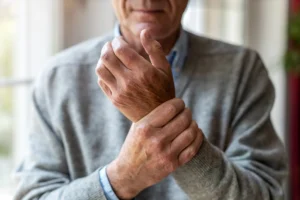Struggling with shoulder pain that won’t subside? Arthroscopic debridement shoulder might be a solution. Designed to remove damaged tissue and reduce discomfort in a minimally invasive manner, this surgery is optimal for those with lingering pain and a desire to regain function. Discover the details of the procedure, recovery period, and alternatives as we dive into what arthroscopic debridement entails for your shoulder health.
Key Takeaways
- Arthroscopic debridement is a minimally invasive surgery aimed at removing damaged tissue from the shoulder joint to alleviate pain and restore functionality, particularly suitable for elderly patients with persistent shoulder pain but good remaining mobility.
- The success of arthroscopic debridement depends on factors such as patient age, severity of joint damage, and presence of mechanical symptoms, with less extensive cases generally leading to better outcomes, though there is a risk of complications such as re-tearing of tendons post-surgery.
- Patients must adhere to preoperative instructions and postoperative care, including medication management and physical therapy, to ensure successful surgery outcomes and recovery; alternative treatments for shoulder pain may be pursued if surgery is not suitable.
Understanding Arthroscopic Debridement for Shoulder Pain
Arthroscopic debridement, in simple terms, is a surgical process that removes damaged tissue from within the shoulder joint using an arthroscope. This technique potentially offers a minimally invasive solution for shoulder pain that targets the root cause of the discomfort.
One might wonder, why opt for arthroscopic debridement? The persistent nature of shoulder pain provides the answer. Often, elderly patients experiencing severe, constant shoulder pain who possess good remaining mobility and low functionality expectations are the ideal candidates for this procedure. It aims to:
- Alleviate pain
- Restore shoulder functionality
- Offer significant pain relief
- Provide a short, straightforward postoperative rehabilitation period.
What is arthroscopic debridement?
At its core, arthroscopic debridement is a surgical process that involves the removal of damaged tissue from the shoulder joint. This procedure is carried out using an arthroscope, a specialized instrument equipped with a camera that transmits images to a monitor in real-time, allowing the surgeon to visualize the interior of the shoulder joint.
As part of the joint repair process, the procedure involves an orthopedic shoulder surgeon removing loose or damaged cartilage and filing down bone spurs. This thorough and strategic approach ensures the removal of all damaged tissue, helping to restore the shoulder joint’s optimal function and alleviate pain.
Why is it performed?
Arthroscopic debridement is generally performed on elderly patients with severe shoulder pain, but who still have good remaining mobility. These are individuals who, despite their discomfort, are able to achieve a preoperative least active forward elevation of 90° and experience pain levels greater than 6/10.
The goal of the procedure is to achieve optimal outcomes for shoulders with sufficiently preserved active mobility, offering significant pain relief. It’s a testament to the power of modern medicine – a process that transforms lives by restoring mobility and minimizing discomfort.
The Benefits and Limitations of Arthroscopic Debridement
Arthroscopic debridement offers a range of benefits. For patients with isolated humeral head defects, the procedure often results in better outcomes for glenohumeral arthritis than those with more extensive joint involvement. The procedure is particularly effective for patients with mechanical symptoms resulting from degenerative conditions like meniscal tears or patellofemoral osteoarthritis.
Keep in mind, however, that factors such as the patient’s age, severity of osteoarthritis per the Kellgren-Lawrence classification, and the presence of mechanical symptoms influence the success rates of arthroscopic debridement. The extent of the disease also affects the success of arthroscopic debridement, with less extensive cases likely resulting in better outcomes.
Pain relief and improved mobility
The primary benefits of arthroscopic debridement are significant pain relief and improved mobility. Studies have found that patients often report satisfaction with the level of pain relief and the increased range of motion after the surgery. This relief from pain, coupled with the restoration of shoulder function, is a game-changer for many patients.
The procedure is particularly beneficial for patients with irreparable rotator cuff tears, including those with asymptomatic rotator cuff tears. Through arthroscopic debridement, surgeons aim to alleviate pain and restore shoulder mobility, offering patients a chance at a more active, pain-free life.
Factors affecting success rates
While arthroscopic debridement can offer significant benefits, its success rates are influenced by various factors, including:
- The patient’s age
- The severity of osteoarthritis according to the Kellgren-Lawrence classification
- The presence of mechanical symptoms
- The extent of the disease
Less extensive cases are likely to result in better outcomes.
It’s also important to note that the risk of a rotator cuff repair failing or the rotator cuff tendon re-tearing post-surgery is about 15-20%, and is higher in older patients. Larger tears, including massive rotator cuff tears, have a higher incidence of tendon re-tear after rotator cuff surgery, posing an additional complication in the healing process of rotator cuff tendons.
Preparing for Arthroscopic Debridement Surgery
Preparing for arthroscopic debridement involves a series of steps to ensure a successful procedure and recovery. Patients are required to provide a full health history and complete medication list to their doctor as part of preoperative assessments. They may also need to stop taking certain medications, including anti-inflammatory drugs, for a period before the procedure.
Patients are also instructed to avoid eating or drinking after midnight on the day before their surgery. Moreover, patients should ensure they have their prescribed pain medications ready by filling their prescriptions the day prior to surgery.
Preoperative assessments
Preoperative assessments are a crucial part of the preparation process. They ensure patient safety and a successful outcome of the surgery. These assessments may include various health checks and evaluations, providing the surgical team with a comprehensive understanding of the patient’s health status.
These preoperative evaluations are essential as they determine the most suitable anesthesia option and identify potential risks and complications. They form the foundation of a successful surgery, ensuring that every step is taken with the patient’s safety and health as a priority.
Patient instructions
Before the surgery, patients receive detailed instructions from the hospital on when to stop eating and drinking. This is to ensure that their system is ready for the anesthesia that will be administered during the procedure.
Additionally, it is essential for patients to arrange for someone to assist them at home after surgery. They will need to rest and may require help with pain management. These preoperative instructions aim to ensure patient comfort and safety during the recovery period.
The Arthroscopic Debridement Procedure: Step by Step
The actual arthroscopic debridement procedure is a meticulous process carried out with utmost precision. The duration of the surgery generally ranges between 1.5 to 2.5 hours, and the technique allows for the use of either the beach chair or lateral decubitus positions. Small incisions are made for the entry of the arthroscope, which provides a visual guide inside the joint, and additional pathways for inserting surgical instruments during the debridement process.
To ensure patient comfort throughout the procedure, anesthesia is administered. The choice between regional and general anesthesia is determined by the patient’s health status and the surgeon’s preference. Following this, the surgeon proceeds to examine the shoulder joint using the two-circle method, utilizing the arthroscope and specialized instruments to remove damaged cartilage and smooth the remainder.
Anesthesia options
The choice of anesthesia is a critical aspect of the arthroscopic debridement procedure. The surgery can be performed under regional anesthesia or general anesthesia, depending on the patient’s overall health and the surgeon’s preference.
An anesthetic block used to numb the arm during the procedure can provide pain relief lasting from 6 to 24 hours post-surgery. This ensures that patients remain comfortable during the initial recovery period, allowing them to focus on rest and healing.
Surgical technique
The surgical technique used in arthroscopic debridement is intricate and precise. During the procedure, surgeons use the arthroscope to guide their movements, ensuring a systematic evaluation and treatment of the shoulder joint.
Portals are created using an outside-in technique under arthroscopic view, ensuring precise placement while avoiding injury to nearby anatomical structures. This meticulous approach ensures comprehensive treatment of the shoulder joint, targeting all areas of damage and promoting optimal healing and recovery.
Recovery and Rehabilitation after Arthroscopic Debridement
Regaining shoulder function and mobility heavily relies on the recovery and rehabilitation following arthroscopic debridement. The recovery period typically spans several weeks, with the total duration varying from patient to patient. During this time, patients generally resume normal activities within a few weeks to several months, depending on the extent of the surgery and their individual healing process.
Physical therapy plays a vital role during the recovery period, helping restore shoulder function and improve range of motion. It is an integral part of the recuperation process that aids in strengthening the muscles around the shoulder joint and improving its mobility.
Immediate postoperative care
Patients recover in the post-operative recovery room after surgery and should arrange for a caregiver to assist them at home on the first day. This is to ensure they receive the necessary care and support during the initial stages of recovery.
After surgery, instructions for pain management include using prescribed medications and applying ice to the surgical area, with an emphasis on keeping the wound dry and avoiding showering for the initial days. Adherence to these instructions plays a significant role in promoting proper healing and preventing complications.
Physical therapy and exercise
Physical therapy is a critical part of the recovery process following arthroscopic debridement, contributing to the strengthening of muscles around the shoulder joint and the improvement of its mobility. Physical therapy post-arthroscopy includes:
- Passive to active range of motion exercises
- Use of a sling
- Isometric workouts
- Strengthening exercises
These exercises ensure that the shoulder, including the shoulder blade, heals correctly and regains optimal function.
Through physical therapy, you can:
- Improve the range of motion in the shoulder joint
- Minimize the chances of future complications
- Reduce the probability of stiffness and permanent restrictions following surgery
Early rehabilitation efforts are instrumental in achieving these goals.
Potential Risks and Complications
As with any surgical procedure, arthroscopic debridement does carry potential risks and complications. Some of the possible risks and complications include:
- Infection
- Bleeding
- Nerve damage
- Blood clots
- Stiffness or loss of range of motion
- Failure to relieve symptoms
The overall reoperation rate after arthroscopic shoulder surgery is approximately 0.4% within a year, with frozen shoulder capsular release surgery having a slightly higher rate of 1%.
Complications from arthroscopic debridement surgery can include:
- Nerve injury
- Infection
- Problems with suture anchors
- Chondrolysis
- Osteoarthritis
- Postoperative stiffness
- Recurrence of shoulder instability
It’s important for patients to be aware of these potential risks and discuss them with their surgeon before undergoing the procedure.
Recurrence of symptoms
There is a risk of recurrence of shoulder instability after shoulder arthroscopy, particularly when it involves arthroscopic debridement, although the rate is reported to be less than 10%. Despite this risk, many patients report positive outcomes and satisfaction with the procedure.
Alternative Treatment Options for Shoulder Pain
Despite arthroscopic debridement being a promising solution to shoulder pain, it is not the sole treatment option available. Alternative strategies for managing shoulder pain include:
- Conservative management
- Physical therapy
- Medications (such as nonsteroidal anti-inflammatory drugs)
- Corticosteroid injections
- Platelet-rich plasma injections
- Other surgical procedures (such as total shoulder replacement or reverse shoulder replacement)
Depending on the patient’s condition, severity of pain, and personal preference, these alternatives can be considered.
Conservative management
Conservative care for shoulder pain includes:
- Medications such as nonsteroidal anti-inflammatory drugs (NSAIDs), prescription medicines, local anesthetics, and over-the-counter pain relievers
- Injections
- Activity modification
- Physical therapy
These treatments are used to manage pain and inflammation.
In addition to medication, injection therapies like cortisone and PRP (Platelet-Rich-Plasma) injections can also be used to address swelling and pain in the shoulder. Lifestyle changes and the employment of assistive devices like slings or braces form an integral part of conservative treatment strategies.
Other surgical procedures
For certain patients, alternative surgical procedures may be necessary. Options such as traditional open repair, arthroscopic rotator cuff repair, and mini-open repair can be considered when repairing a rotator cuff tear, which involves the rotator cuff muscles.
In cases where surgery is being considered, other treatment strategies such as:
- massage therapy
- injections
- physical therapy
- pain management
Physical therapy and targeted exercises can be combined as effective non-surgical treatments for shoulder injuries, including those involving the biceps tendon.
Summary
Navigating the complex world of shoulder pain is a challenging task, and arthroscopic debridement offers a beacon of hope for many patients. From understanding the procedure to exploring its benefits, preparing for the surgery, and learning about recovery and rehabilitation, this comprehensive guide has aimed to provide a clear and in-depth understanding of arthroscopic debridement. As with any medical procedure, it’s important to discuss your options with a healthcare professional to determine the best treatment option for your specific condition. Remember, you’re not alone in your journey towards a pain-free life – there’s a world of help and support available, and a brighter, pain-free future is within reach.
Frequently Asked Questions
What is arthroscopic debridement?
Arthroscopic debridement is a surgical procedure that removes damaged tissue from the shoulder joint using an arthroscope. It helps to alleviate pain and improve joint function.
Who is an ideal candidate for arthroscopic debridement?
Elderly patients with severe and constant shoulder pain and good remaining mobility are the ideal candidates for arthroscopic debridement. It is recommended for others with similar conditions as well.
How long does recovery from arthroscopic debridement take?
Recovery from arthroscopic debridement typically takes several weeks, but the exact duration varies for each patient.
What are the potential risks and complications of arthroscopic debridement?
The potential risks and complications of arthroscopic debridement include nerve injury, infection, problems with suture anchors, chondrolysis, osteoarthritis, postoperative stiffness, and recurrence of shoulder instability. It’s essential to be aware of these potential issues before undergoing the procedure.
Are there alternatives to arthroscopic debridement for treating shoulder pain?
Yes, conservative management and other surgical procedures are alternative strategies for managing shoulder pain. Consider exploring these options before deciding on arthroscopic debridement.





